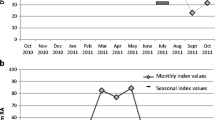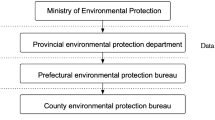Abstract
Traditional approaches for benchmarking drinking water systems are binary, based solely on the compliance and/or non-compliance of one or more water quality performance indicators against defined regulatory guidelines/standards. The consequence of water quality failure is dependent on location within a water supply system as well as time of the year (i.e., season) with varying levels of water consumption. Conventional approaches used for water quality comparison purposes fail to incorporate spatiotemporal variability and degrees of compliance and/or non-compliance. This can lead to misleading or inaccurate performance assessment data used in the performance benchmarking process. In this research, a hierarchical risk-based water quality performance benchmarking framework is proposed to evaluate small drinking water systems (SDWSs) through cross-comparison amongst similar systems. The proposed framework (R WQI framework) is designed to quantify consequence associated with seasonal and location-specific water quality issues in a given drinking water supply system to facilitate more efficient decision-making for SDWSs striving for continuous performance improvement. Fuzzy rule-based modelling is used to address imprecision associated with measuring performance based on singular water quality guidelines/standards and the uncertainties present in SDWS operations and monitoring. This proposed R WQI framework has been demonstrated using data collected from 16 SDWSs in Newfoundland and Labrador and Quebec, Canada, and compared to the Canadian Council of Ministers of the Environment WQI, a traditional, guidelines/standard-based approach. The study found that the R WQI framework provides an in-depth state of water quality and benchmarks SDWSs more rationally based on the frequency of occurrence and consequence of failure events.











Similar content being viewed by others
References
American Water Works Association (AWWA). (1999). Standard methods for the examination of water and wastewater.
Bereskie, T., Haider, H., Rodriguez, M. J., & Sadiq, R. (2017). Framework for continuous performance improvement in small drinking water systems. Science of the Total Environment, 574, 1405–1414. doi:10.1016/j.scitotenv.2016.08.067.
Bhuiyan, N., & Baghel, A. (2005). An overview of continuous improvement: from the past to the present. Management Decision, 43(5), 761–771. doi:10.1108/00251740510597761.
Canadian Council of Ministers of the Environment (CCME). (2001). Water quality index 1.0 technical reportx. Retrieved from http://www.ccme.ca/files/Resources/calculators/WQITechnicalReport(en).pdf
CCME. (2004). From source to tap: guidance on the multi-barrier approach to safe drinking water. Winnipeg.
Chang, E. E., Chiang, P. C., Chao, S. H., & Chuang, C. L. (1999). Development and implementation of source water quality standards in Taiwan, ROC. Chemosphere, 39(8), 1317–1332. doi:10.1016/S0045-6535(99)00035-1.
Corton, M. L. (2003) Benchmarking in the Latin American water sector: the case of Peru. Utilities Policy, 11(3), 133–142.
Corton, M., & Berg, S. (2009). Benchmarking central American water utilities. Utilities Policy, 17(3–4), 267–275 Retrieved from http://www.sciencedirect.com/science/article/pii/S0957178708000891.
Coulibaly, H. D., & Rodriguez, M. J. (2003). Spatial and temporal variation of drinking water quality in ten small Quebec utilities. Journal of Environmental Engineering and Science, 2(1), 47–61. doi:10.1139/s03-001.
Dionne, G. (2013). Risk management: history, definition and critique (Vol. 17).
Dyck, R., Cool, G., Rodriguez, M., & Sadiq, R. (2014). Treatment, residual chlorine and season as factors affecting variability of trihalomethanes in small drinking water systems. Frontiers of Environmental Science & Engineering, 9, 1–9. doi:10.1007/s11783-014-0750-1.
Elmuti, D., & Kathawala, Y. (1997). An overview of benchmarking process: a tool for continuous improvement and competitive advantage. Benchmarking: An International Journal, 4(4), 229–243. doi:10.1108/14635779710195087.
Francisque, A., Rodriguez, M. J., Miranda-Moreno, L. F., Sadiq, R., & Proulx, F. (2009). Modeling of heterotrophic bacteria counts in a water distribution system. Water Research, 43(4), 1075–1087. doi:10.1016/j.watres.2008.11.030.
Goodwin, D., Raffin, M., Jeffrey, P., & Smith, H. M. (2015). Apply the water safety plan to water reuse: towards a conceptual risk management framework. Environmental Science: Water Research & Technology, 1, 709–722. doi:10.1039/C5EW00070J.
Guilherme, S., & Rodriguez, M. J. (2014). Occurrence of regulated and non-regulated disinfection by-products in small drinking water systems. Chemosphere, 117C, 425–432. doi:10.1016/j.chemosphere.2014.08.002.
Haider, H., Sadiq, R., Tesfamariam, S. (2014). Performance indicators for small and medium sized water supply systems: A review. Environmental Reviews, 22(1), 1–40.
Haider, H., Sadiq, R., & Tesfamariam, S. (2015). Selecting performance indicators for small to medium sized water utilities: multi-criteria analysis using ELECTRE method. Urban Water Journal, 12(4), 305–327.
Haider, H., Sadiq, R., & Tesfamariam, S. (2016a). Inter-utility performance benchmarking model for small-to-medium-sized water utilities: aggregated performance indices. Journal of Water Resources Planning and Management, 142(1), 04015039.
Haider, H., Sadiq, R., & Tesfamariam, S. (2016b). Intra-utility performance management model (in-UPM) for the sustainability of small to medium sized water utilities: conceptualization to development. Journal of Cleaner Production, 133(2016), 777–794.
Haider, H., Sadiq, R., & Tesfamariam, S. (2016c). Risk-based framework for improving customer satisfaction through system reliability in small-sized to medium-sized water utilities. Journal of Management in Engineering, 32(5), 04016008.
Health Canada. (2014). Guidelines for Canadian drinking water quality summary table. Ottawa. Retrieved from http://www.hc-sc.gc.ca/ewh-semt/pubs/water-eau/sum_guide-res_recom/index-eng.php#e
Hurley, T., Sadiq, R., & Mazumder, A. (2012). Adaptation and evaluation of the Canadian Council of Ministers of the environment water quality index (CCME WQI) for use as an effective tool to characterize drinking source water quality. Water Research, 46(11), 3544–3552. doi:10.1016/j.watres.2012.03.061.
Islam, N., Sadiq, R., & Rodriguez, M. J. (2013a). Optimizing booster chlorination in water distribution networks: a water quality index approach. Environmental Monitoring and Assessment, 185(10), 8035–8050. doi:10.1007/s10661-013-3153-z.
Islam, N., Sadiq, R., Rodriguez, M. J., & Francisque, A. (2013b). Evaluation of source water protection strategies: a fuzzy-based model. Journal of Environmental Management, 121, 191–201. doi:10.1016/j.jenvman.2013.02.022.
Lee, C. (1990). Fuzzy logic in control systems: fuzzy logic controller, parts I and II. IEEE Transactions on Systems, Man, and Cybernetics, 20, 404–435.
Mamdani, E. H., & Assilian, S. (1975). An experiment in linguistic synthesis with a fuzzy logic controller. International Journal of Man-Machine Studies, 7(1), 1–13.
Marques, R. C., Berg, S., & Yane, S. (2014). Nonparametric benchmarking of Japanese water utilities: Institutional and environmental factors affecting efficiency. Journal of Water Resources Planning and Management, 140(5), 562–571. doi:10.1061/(ASCE)WR.1943-5452.0000366
Mitchell, V. (1999). Consumer perceived risk: conceptualizations and models. European Journal of Marketing, 33(1/2), 163–195. doi:10.1108/03090569910249229.
Mujumdar, P. P., & Sasikumar, K. (2002). A fuzzy risk approach for seasonal water quality management of a river system. Water Resources Research, 38(1), 5–9. doi:10.1029/2000WR000126.
Ontario Ministry of Health and Long-Term Care (MOHLTC). (2008). Small drinking water systems (SDWS) risk assessment directives guideline document.
Rodriguez, M., Vinette, Y., Serodes, J., & Bouchard, C. (2003). Trihalomethanes in drinking water of greater Quebec region (Canada): Occurrence, variations and modelling. Environmental Monitoring and Assessment, 89(1), 69–93. doi:10.1023/A:1025811921502.
Ross, T. J. (2010). Fuzzy logic with engineering applications. Wiley (Third Edit). 10.1002/9781119994374.
Sadiq, R., Kleiner, Y., & Rajani, B. (2003). Forensics of water quality failure in distribution system: a conceptual framework. Indian Water Works Association, 35(4), 267–278 Retrieved from http://citeseerx.ist.psu.edu/viewdoc/download?doi=10.1.1.86.8137&rep=rep1&type=pdf.
Sadiq, R., Kleiner, Y., & Rajani, B. B. (2004). Aggregative risk analysis for water quality failure in distribution networks. Journal of Water Supply Research and Technology, 53(4), 241–261.
Sadiq, R., Kleiner, Y., & Rajani, B. (2009). Q-WARP proof-of-concept model to predict water quality failures in distribution pipe networks. Denver.
Scheili, A., Rodriguez, M. J., & Sadiq, R. (2014). Seasonal and spatial variations of source and drinking water quality in small municipal systems of two Canadian regions. Science of the Total Environment, 508, 514–524. doi:10.1016/j.scitotenv.2014.11.069.
Scheili, A., Rodriguez, M. J., & Sadiq, R. (2015). Development, application, and sensitivity analysis of a water quality index for drinking water management in small systems. Environmental Monitoring and Assessment, 187(11), 685. doi:10.1007/s10661-015-4908-5.
Seltzer, M., Krinsky, D., Smith, K., & Zhang, X. (1999). The case for application-specific benchmarking. In HOTOS Proceedings of the Seventh Workshop on Hot Topics in Operating Systems (pp. 102–109). Washington, D.C.
Statistics Canada. (2010). Human activity and the environment freshwater supply and demand in Canada. Retrieved from http://www.statcan.gc.ca/pub/16-201-x/2010000/t236-eng.htm
Statistics Canada. (2011). Population and dwelling counts for 2011 census.
Statistics Canada. (2013). Average daily treated water volumes per month for Canada and selected drainage regions, 2005 to 2007. Retrieved from http://www.statcan.gc.ca/pub/16-403-x/2013001/ct002-eng.htm
Sugeno, M. (1985). An introductory survey on fuzzy control. Information Sciences, 36, 59–83.
Swamee, P. K., & Tyagi, A. (2000). Describing water quality with aggregate index. J. Env. Eng, 126(5), 451–455.
Turner, S. W. D., Blackwell, R. J., Smith, M. A., & Jeffrey, P. J. (2016). Risk-based water resources planning in England and Wales: challenges in execution and implementation. Urban Water Journal, 13(2), 182–197. doi:10.1080/1573062X.2014.955856.
United States Environmental Protection Agency (USEPA). (2009). National primary drinking water regulations. Retrieved from http://www.ncbi.nlm.nih.gov/pubmed/11800007
United States Food and Drug Administration (USFDA). (2006). Guidance for industry. Q9 quality risk management. Rockville. Retrieved from www.fda.gov/cder/guidance/index.htm.
World Health Organization (WHO). (2011). Guidelines for drinking water quality (Vol. 4). Geneva.
Zadeh, L. A. (1965). Fuzzy sets. Information and Control, 8(3), 338–353.
Acknowledgements
This work was funded by the National Science and Engineering Research Council (NSERC) [Grant Number: NETGP 434849-12] and RES’EAU WaterNET.
Author information
Authors and Affiliations
Corresponding author
Appendix
Appendix
Rights and permissions
About this article
Cite this article
Bereskie, T., Haider, H., Rodriguez, M.J. et al. Small drinking water systems under spatiotemporal water quality variability: a risk-based performance benchmarking framework. Environ Monit Assess 189, 464 (2017). https://doi.org/10.1007/s10661-017-6176-z
Received:
Accepted:
Published:
DOI: https://doi.org/10.1007/s10661-017-6176-z




